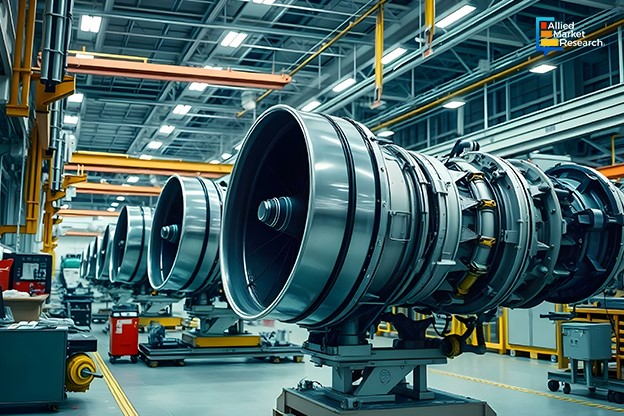Aerospace Parts Manufacturing: Introduction of 3D Printing and AI Transforming the Industry

5 May
2025
Highlights:
- Introduction
- Role of 3D printing in the growth of the sector
- Integration of AI in the industry
In the last few years, the number of geopolitical conflicts has increased significantly. The Russia-Ukraine war, Israel-Palestine dispute, and India-Pakistan tensions have led to a surge in demand for military aircraft and jets. Naturally, aerospace companies have focused on boosting their production capabilities to address the demands of their clients efficiently. Several multinational businesses have started investing in the establishment of innovative design, production, and assembly processes to improve their rate of aerospace parts manufacturing. At the same time, regulatory standards enacted by governments across the globe have compelled these firms to start R&D projects for developing new prototypes that comply with the norms.
Impact of 3D printing on the aerospace parts manufacturing industry
The evolving industry dynamics have led to a gradual shift toward additive manufacturing techniques such as 3D printing to improve their efficiency and productivity. Compared to automobile components, aerospace parts are much more complicated, thus requiring advanced methodologies and sophisticated production processes. The flexibility offered by 3D printing makes it an ideal solution to manufacture these components with intricate detailing.
Along with this, another important advantage of 3D printing is that of rapid prototyping, which helps in reducing the time required for actual manufacturing. Once the design is fed to the slicer software, the printing equipment starts creating geometric patterns and shapes as per the requirement without any interruptions. Engineering studies have shown that companies have been able to bring down their production hours from several months to a few weeks with the adoption of additive manufacturing techniques. This has enabled firms to meet their deadlines, increase their credibility in the market, and ultimately expand their footprint in the industry. Most importantly, 3D printing techniques have assisted businesses in lowering their production costs drastically through resource optimization and waste reduction. As a result, many aerospace companies have started realigning their operations to accommodate additive manufacturing methods.
Along with this, several companies have established strategic alliances with their peers to strengthen their position in the aerospace parts manufacturing industry. For instance, in June 2024, Stratasys Ltd., an additive manufacturing company, announced a partnership with AM Craft, another leading player in the 3D printing sector. As part of this business deal, both companies agreed to pool their resources and expertise to develop a framework for the production of flight-certified 3D printed aviation parts. The collaboration is expected to boost the revenue share of these firms substantially in the coming period.
Adoption of AI in aerospace parts manufacturing opening new investment opportunities
The growing integration of Artificial Intelligence in aircraft component production processes is predicted to aid the industry in gathering a revenue of $1.94 trillion by 2031. The market accounted for $0.85 trillion in 2021 and is predicted to surge at a CAGR of 9.2% during 2022-2031. The deployment of AI tools has helped companies streamline their supply chains by analyzing the data regarding client preferences and purchasing patterns. Based on this information, these tools can forecast the demands and identify the issues that are likely to disrupt the company’s operations in the near future. This enables firms to make necessary changes to their processes and manage their inventories more proactively. Furthermore, the predictive maintenance capabilities offered by AI-powered solutions aid enterprises in reducing their repair cost and time, thus increasing their profitability in the long run.
Many key players in the aviation sector have invested in AI and machine learning to maximize their revenue share in the coming period. In February 2025, GE Aerospace, an aerospace technology supplier, announced the launch of an AI-driven inspection tool to enhance the performance of narrowbody aircraft engines. As per the press release issued by the company, this new solution is designed to improve the "time on wing" for engines to ensure that the engines remain operational for longer periods before requiring maintenance.
In essence, the aerospace parts manufacturing sector is predicted to experience significant growth due to the growing number of geopolitical tensions and conflicts across the globe. Furthermore, the transition toward 3D printing and the integration of AI tools in production processes are anticipated to create favorable conditions for the growth of the market in the coming period.
Contact our experts for valuable insights into the various factors shaping the aerospace parts manufacturing industry.

Akhilesh Prabhugaonkar
Author's Bio- Akhilesh Prabhugaonkar holds a bachelor’s degree in Electronics Engineering from the reputed Vishwakarma Institute of Technology. He has a special interest in the fields of forensics, world history, international relations and foreign policy, sports, agriculture, astronomy, security, and oceanography. An ardent bibliophile and melophile, Akhilesh loves to write on topics of his interest and various other societal issues. This love for writing made him enter the professional world of content writing and pursue his career in this direction.
Avenue: Entire Library membership of Allied Market Research Reports at your disposal
- Avenue is an innovative subscription-based online report database.
- Avail an online access to the entire library of syndicated reports on more than 2,000 niche industries and company profiles on more than 12,000 firms across 11 domains.
- A cost-effective model tailored for entrepreneurs, investors, and students & researchers at universities.
- Request customizations, suggest new reports, and avail analyst support as per your requirements.
- Get an access to the library of reports at any time from any device and anywhere.
Related Post
-
How are Submarine Cables Transforming Global Connectivity with Enhanced User Experience?
-
Endoscopy Procedures: Transformations in Techniques and Applications
-
AI-Powered Video Analytics: How the Product Actually Works for enterprises
-
Painting Robots: Transforming Precision Coating and Creative Applications
-
Innovations in Pharmacovigilance Systems Advancing Patient Safety
-
Understanding Edge Security: Keeping Data Safe Near the Source
-
Exploring the Use and Advancements of 3D Laser Scanners in Professional Applications
-
Reinforcing Industrial Controls with Smarter Tools and Training








